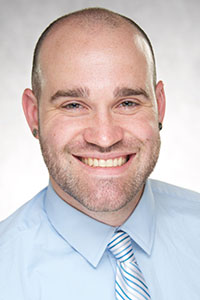Breadcrumb
Q&A: Addressing COVID-19 vaccine hesitancy
Published on January 25, 2021
 The distribution of COVID-19 vaccines is underway across the U.S., but limited supplies, complicated logistics, and misinformation are hampering the rollout. Additionally, a sizeable proportion of the population harbors doubt or distrust about the vaccines.
The distribution of COVID-19 vaccines is underway across the U.S., but limited supplies, complicated logistics, and misinformation are hampering the rollout. Additionally, a sizeable proportion of the population harbors doubt or distrust about the vaccines.
University of Iowa researchers Aaron Scherer, assistant professor of internal medicine in the Carver College of Medicine, and Natoshia Askelson, assistant professor of community and behavioral health in the College of Public Health, study vaccine hesitancy. They recently weighed in on why people may not feel confident in the vaccines, what messages public health needs to deliver, how to discuss vaccines with those who are hesitant, and more.
Q: Vaccinating a majority of the U.S. population is crucial to controlling the COVID-19 pandemic, yet recent surveys show that a large number of people say they probably or definitely will not get the vaccine. Why do you think so many people, including health care workers, are hesitant about the vaccine?

Scherer: The major concern is that the speed that the COVID vaccines have been developed and made available potentially undermines the safety of the vaccines. Surprisingly, if vaccination is not incentivized or mandated, health care workers have essentially the same influenza vaccination rates as the general public.
A less prevalent, but still important, factor associated with COVID vaccine hesitancy is the belief that the risks of COVID are being overblown or that COVID doesn’t actually exist. In a recent survey I conducted, 20%—1 out of every 5—Americans thought it was “probably” or “definitely” true that COVID is a hoax. Obviously if you don’t think COVID is a threat, then why would you get a COVID vaccine?
Q: What are some of the considerations that public health has to take into account as it develops and delivers messages about the COVID vaccine to a variety of populations?

Askelson: Most vaccine communication messages are not very complicated, but this one really is. We not only have to consider issues related to various populations—older Iowans, people working in industries that put them in increased risk for COVID-19, people with co-morbidities, people who may have limited access to health care—but we also have complex information that we have to communicate.
For example, we can’t just say “Go get vaccinated,” because for most people the vaccine is not available to them right now. We also can’t succinctly communicate about where people can get the vaccine because it depends on which distribution phase you are in and who has vaccine in your county. We also can’t give very specific directions about how to access the vaccine. For most vaccines we are able to say “Call your health care provider,” but for this vaccine, it is not clear if you will get your vaccine at your health care provider’s office.
We also can’t communication with people about which vaccine they will get, how many doses they need, or what, if any, the side effects might be or even how effective the vaccine is. It is great that more vaccines are being developed, but it means that people being vaccinated in April 2021, might have access to different vaccines than those who were vaccinated in January 2021.
We also know that not all populations can be communicated with using the same methods or channels. For some people social media might be perfect, but others might need to hear about the vaccine through a trusted community member or their place of worship.
Scherer: To build on that, some key considerations for crafting public health messages are:
- Addressing Safety Concerns. Vaccine safety is the biggest concern that Americans have about the COVID vaccines, so there will be a need to communicate why the vaccines are safe, even at the speed they were developed.
- Cultivating Trust. Mistrust in science and medicine is a key predictor of COVID vaccine hesitancy. Mistrust is present in some communities, such as African Americans, based on prior experience with unethical research being conducted on them.
- Dealing with Misinformation/Conspiracy Theories. COVID and COVID vaccine misinformation and conspiracy theories are everywhere. In one of my recent studies, 70% of the participants endorsed at least one COVID conspiracy theory.
- Community Participation. It is critical that we promote the COVID vaccines using language and concepts that resonate with the communities we are trying to reach. This means we need to partner with members of these communities to create vaccine messages, as well as having trusted members of those communities being the ones promoting COVID vaccination to members of their community.
Q: What are some ways to educate the public about vaccines? Along the same lines, any advice for talking to friends and family who are hesitant about the COVID-19 vaccine?
Askelson: We know that we have to make the messages speak to people. Some people will be motivated by the chance to get everything back to normal. Others, like employers, will be interested in making sure their employees stay healthy. It does look like there are also people motivated to be vaccinated so that they can protect others, including their friends and family.
It can be difficult to have conversations with family and friends who might not share your values or trust in science. It is important to recognize their concerns and try to understand what might be influencing their hesitancy—is it a concern about safety, or a distrust in science or the government, or a belief in a myth about COVID-19? Trying to figure out what is driving the hesitancy can point to what they might need to hear to change their opinion. It is possible to move people who are vaccine hesitant to a place of more confidence and intention to get the vaccine. For people who are anti-vaccine, you might be better off trying to support the people around them to be vaccinated.
Scherer: Discussing vaccines is a tricky business. On the one hand, you want to correct misinformation about vaccines by providing corrective information. While this may help people who are relatively positive or neutral towards vaccines, some studies have shown that providing corrective information to people with negative vaccine attitudes can produce a “backfire effect.” In other words, the information may successfully correct the mistaken belief but it will also decrease their vaccination intentions, which is the outcome we really care about!
While the possibility of a backfire effect exists, there are a number of things that need to be communicated more clearly. One thing we need to focus on is better communicating the WHY behind public health recommendations. For example, instead of simply telling the public that the COVID vaccines are safe, we need to better communicate the reasons why we were able to develop the vaccines so quickly without undermining vaccine safety. Dr. Pat Winokur in the Carver College of Medicine is one of the best people at discussing the COVID vaccine in a way that meets the public where they are at, not where we want them to be.
Another major area that we need to better communicate is WHEN people can expect to be eligible for vaccination. Hospitals, clinics, and pharmacies are being inundated with people asking for the COVID vaccine. While it’s great to see people wanting to be vaccinated, we run the risk of these people becoming disappointed that the vaccine is not available to them right now and decide to forego vaccination when they become eligible. This is something that we saw during the 2009 H1N1 influenza pandemic. Simply telling people who is eligible at each phase of the vaccine rollout is incredibly vague and does very little to help people estimate when they might be eligible. We should give the public a conservative timeline for when each group might become eligible for vaccination.
A final point is that we should be compassionate when talking with people who are vaccine hesitant. If a vaccine-hesitant person seems to be acting in good faith, chances are that they are simply trying to make the right decisions for them based on the information they have. Rather than hammering them with facts about vaccines, try to take time to understand what feelings or motivations might be producing their resistance to being vaccinated.
Q: Dr. Scherer, you’re the principal investigator on a CDC grant to survey primary care providers and the general public on various immunization-related issues. Can you describe a little more about what the goals of that grant are?
Scherer: The goal of my CDC grant is to get information about an important or salient vaccine-related issue that might help inform CDC vaccine recommendations or understanding how health care providers currently approach vaccination. To this end, we will conduct surveys of health care providers approximately every four months. In the past this was done almost exclusively with pediatricians, family physicians, and general internists. Our recruitment methodology provides us with more flexibility though, allowing us to do things like recruit from other medical specialties or conduct rapid surveys with the general public if there is a vaccine- or infectious disease-related crisis.
Q: Dr. Askelson, are there lessons that you can apply to the COVID vaccine based on your previous research on HPV vaccine acceptance?
Askelson: As with most health behaviors, people are most likely to do them if their health care provider recommends it. Unfortunately, most people will not see their health care provider before they need to vaccinated, so we can’t use this as our only strategy.
For most vaccines, there are people who will get vaccinated with no questions or hesitation, there will be some people who have hesitation and just need their concerns addressed, and there is a group of people who are strongly against the vaccine. This final group is hard to convince and may never get vaccinated.
Q: Anything else you’d like to add?
Askelson: There are many organizations at the national, state, and local level that are working on communicating with people about the COVID-19 vaccination. It is energizing and reassuring that so many people are contributing their energy and expertise to tackle this issue. Unfortunately, the dissemination of the vaccine is complicated and has not benefited from strong national leadership. People need to be patient, continue to wear masks, stay at home when possible, and social distance until everyone has been vaccinated.